Q2.1
Define the term solution. How many types of solutions are formed? Write briefly
about each type with an example.
Solution






Q2.2
Give an example of a solid solution in which the solute is a gas.
Solution


Q2.3
Define the following terms :
(i) Mole fraction
(ii) Molality
(iii) Molarity
(iv) Mass percentage. Solution


(i) Mole fraction
(ii) Molality
(iii) Molarity
(iv) Mass percentage. Solution



Q2.4
Concentrated nitric acid used in laboratory work is 68% nitric acid by mass in
aqueous solution. What should be the molarity of such a sample of the acid if
the density of the solution is 1.504 g mL-1?
Solution




Q2.5
A Solution of glucose in water is labelled as 10% w/w, what would be the molality and mole fraction of
each component in the solution? If the density of solution is 1.2 g mL-1 then what shall be
the molarity of the solution?
Solution






Q2.6
How many mL of 0.1 M HCl are required to react completely with 1 g mixture of
Na2CO3 and NaHCO3 containing equimolar amounts of both?
Solution




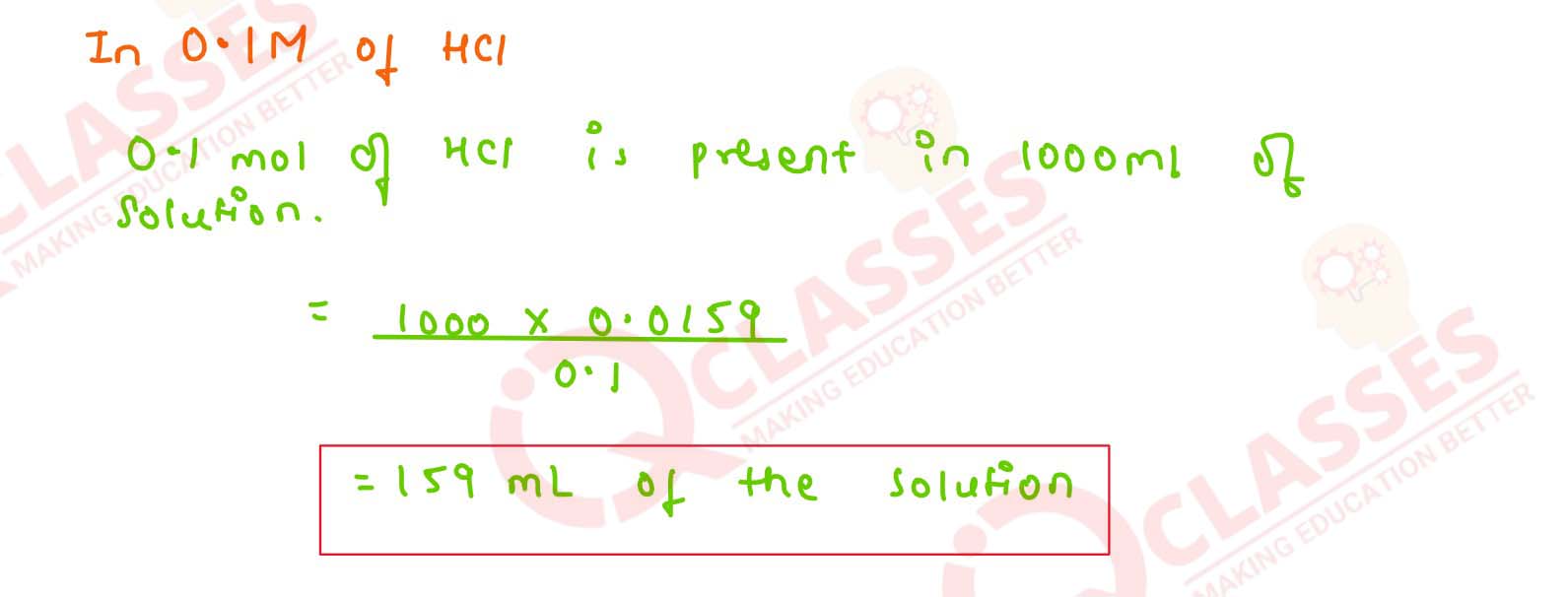





Q2.7
A solution is obtained by mixing 300 g of 25% solution and 400 g of 40% solution by mass. Calculate the
mass percentage of the resulting solution.
Solution








Q2.8
An antifreeze solution is prepared from 222.6 g of ethylene glycol
(C2H6O2) and 200 g of water. Calculate the molality of the Solution. If
the density of the solution is 1.072 g mL-1. then what shall be the molarity of the solution?
Solution




Q2.9
A Sample of drinking water was found to be severely contaminated with chloroform (CHCl3)
Supposed to be a carcinogen. The level of contamination was 15 ppm (by mass):
(i) express this in percent by mass
(ii) determine the molality of chloroform in the water sample
Solution


(i) express this in percent by mass
(ii) determine the molality of chloroform in the water sample
Solution



Q2.10
What does molecular interaction play in a solution of alcohol and water.
Solution
















Q2.11
Why do gases always tend to be less soluble in liquid as the temperature is raised
Solution


Q2.12
State Henry's law and mentioned some important applications.
Solution


Q2.13
The partial pressure of ethane over the solution containing 6.53 x 10-3g of ethane is 1 bar.
If the solution contains 5.00 x 10-2g of ethane then what shall be the partial pressure of
the gas?
Solution






Q2.14
What is meant by positive and ne gative deviations from Raoult's law and how is the sign of
∆mixH related to positive and negative deviations from Raoult's law?
Solution


Q2.15
An aqueous solution of 2% non-volatile solute exerts a pressure of 1.004 bar at the normal boiling point
of the solvent. What is the molar mass of the solute?
Solution


Q2.16
Heptane and octane form an ideal sol the two liquid components are 105.2 be the vapour pressure of a
mixture
ution. At 373 K, the Vapour pressures of kPa and 46.8 kPa respectively. What will of 26.0 g of heptane
and 35 g of octane?
Solution




Q2.17
The vapour pressure of water is 12.3 kPa at 300 K. Cal culate vapour pressure of 1 molal solution of a
non-volatile solute in it.
Solution






Q2.18
Calculate the mass of a non-volatile solute (molar mass 40 g mol-1) which should be dissolved
in 114 g octane to reduc € its vapour pressure to 80%.
Solution


Q2.19
A solution containing 30 g of non-volatile solute exactly in 90 g of water has a vapour pressure of 2.8
kPa at 298 K. Further, 18 g of water is then added to the solution and the new vapour pressure becomes
2.9 kPa at 298 K. Calculate:
(i) molar mass of the solute
(ii) vapour pressure of water at 298 K. Solution
(i) molar mass of the solute
(ii) vapour pressure of water at 298 K. Solution

Q2.20
A 5% solution (by mass) of cane sugar in water has freezing point of 271K. Calculate the freezing point
of 5% glucose in water if freezing point of pure water is 273.15 K.
Solution


Q2.21
Two elements A and B form compounds having formula AB2 and AB4 . When dissolved in 20
g of benzene (C6H6). 1 g of AB2 lowers the freezing point by 2.3
K whereas 1.0 g of AB4 lowers it by 1.3 K. The molar depression constant for benzene is 5.1 K
kg mol-1. Calculate atomic masses of A and B.
Solution


Q2.22
At 300 K, 36 g of glucose present in a litre of its solution has an osmotic pressure
of 4.98 bar. If the osmotic pressure of the solution is 1.52 bars at the same
temperature, what would be its concentration?
Solution






Q2.23
Suggest the most important type of intermolecular attractive interaction in |
the following pairs.
(i) n-hexane and n-octane
(ii) I2 and CCl4
(iii) NaClO4, and water
(iv) methanol and acetone
(v) acetonitrile (CH3CN) and acetone (C3H6O).
Solution


(i) n-hexane and n-octane
(ii) I2 and CCl4
(iii) NaClO4, and water
(iv) methanol and acetone
(v) acetonitrile (CH3CN) and acetone (C3H6O).
Solution



Q2.24
Based on solute-solvent interactions, arrange the following in order of increasing
A solubility in n-octane and explain. Cyclohexane, KCl , CH3OH, CH3CN.
Solution




Q2.25
Amongst the following compounds, identify which are insoluble, partially
soluble and highly soluble in water?
(i) phenol
(ii) toluene
(iii) formic acid
(iv) ethylene glycol
(v) chloroform
(vi) pentanol. Solution


(i) phenol
(ii) toluene
(iii) formic acid
(iv) ethylene glycol
(v) chloroform
(vi) pentanol. Solution



Q2.26
If the density of some lake water is 1.25g mL-1 and contains 92 g of Na+ ions per
kg of water, calculate the molality of Na+ ions in the lake.
Solution








Q2.27
If the solubility product of CuS is 6 x 10-16, calculate the maximum molarity of
CuS in aqueous solution.
Solution








Q2.28
Calculate the mass percentage of aspirin (C9H8O4) in acetonitrile
(CH3CN) when
6.5 g of C9H8O4 is dissolved in 450 g of CH3CN.
Solution








Q2.29
Nalorphene (C19H21NO3), similar to morphine, is used to combat
withdrawal
symptoms in narcotic users. Dose of nalorphene generally given is 1.5 mg.
Calculate the mass of 1.5 - 10-3 m aqueous solution required for the above dose.
Solution








Q2.30
Calculate the amount of benzoic acid (C6H5COOH) required for preparing 250
mL of 0.15 M solution in methanol.
Solution








Q2.31
The depression in freezing point of water observed for the same amount of acetic acid, trichloroacetic
acid and trifluoroacetic acid increases in the order given above. Explain briefly.
Solution








Q2.32
Calculate the depression in the freezing point of water when 10 g of
CH3CH2CHCICOOH is added to 250 g of water. Kn = 1.4 x 10-3,
Kf = 1.86 K kg mol-1.
Solution

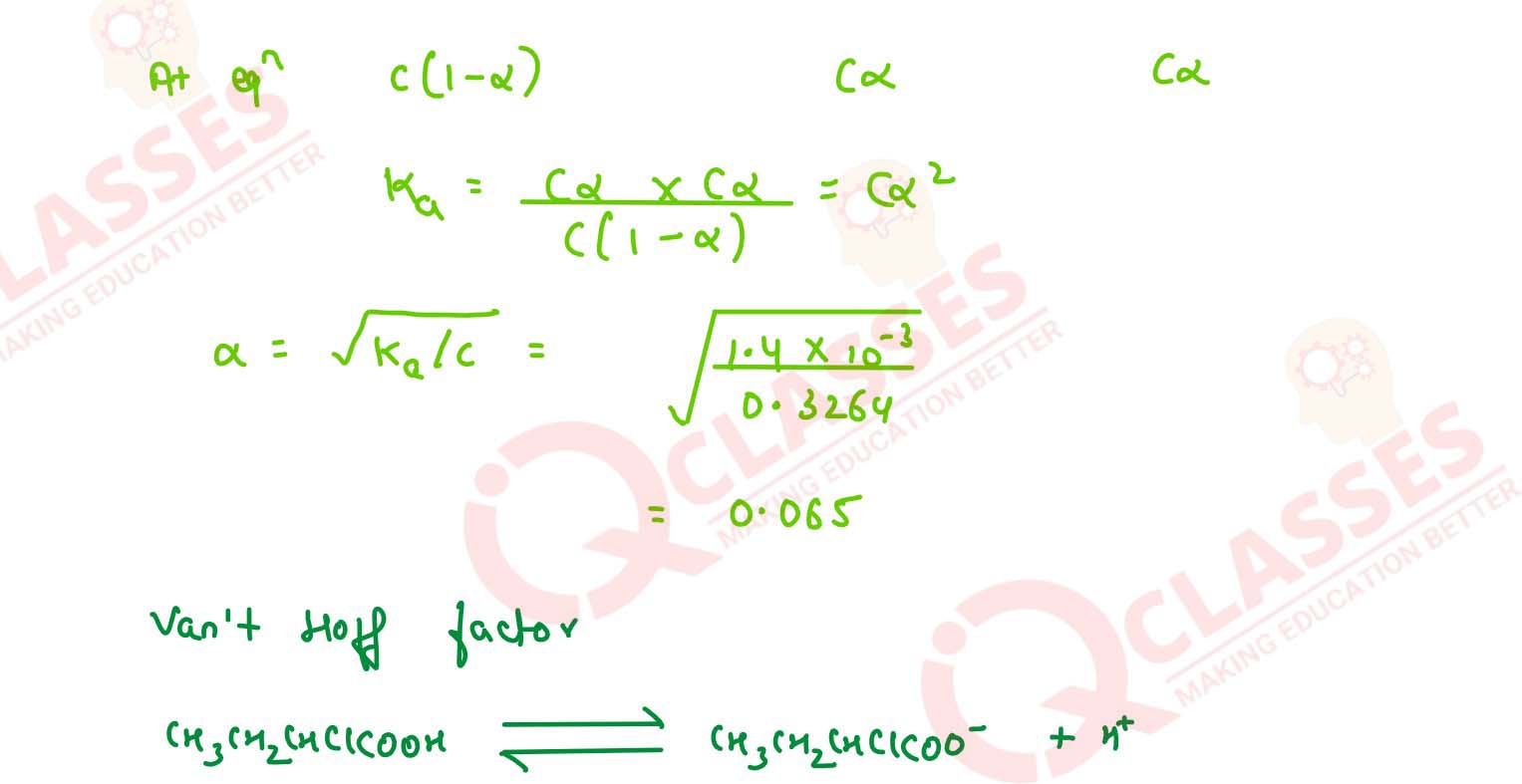
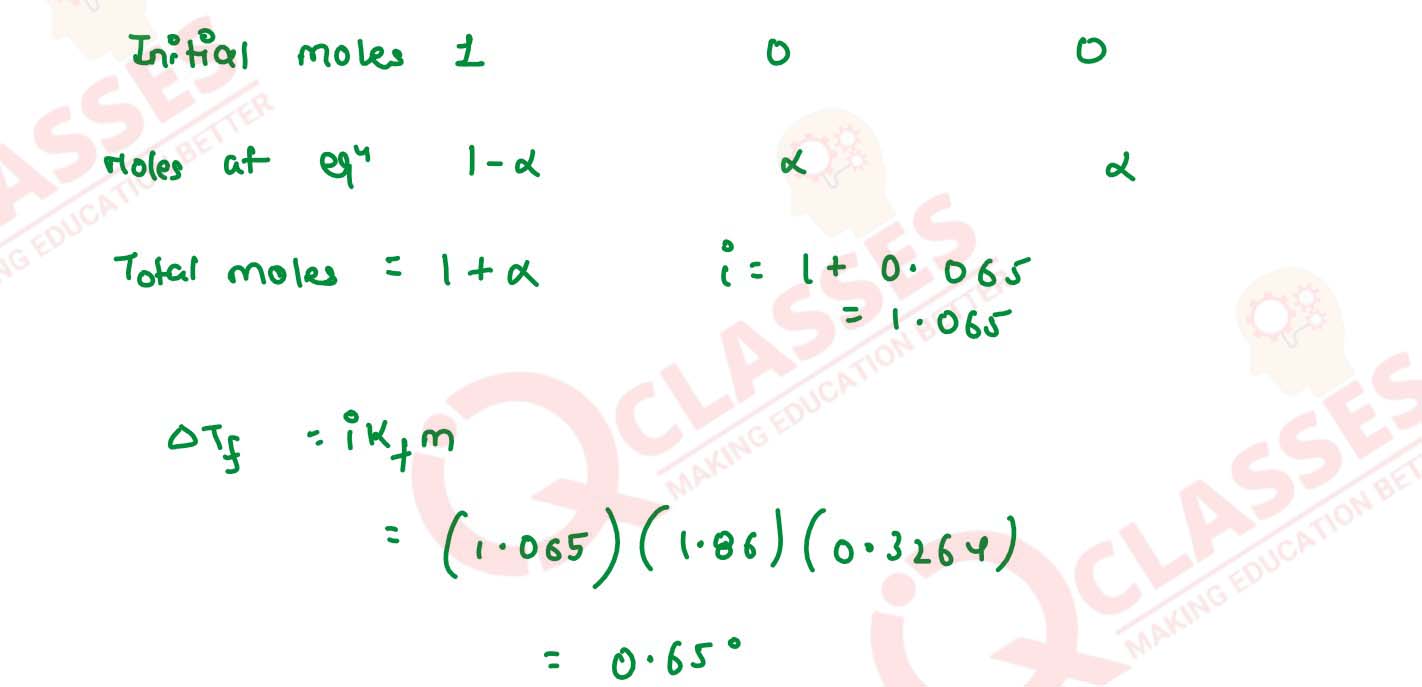



Q2.33
19.5 g of CH2FCOOH is dissolved in 500 g of water. The depression in the freezing point of
water observed is 10C. Calculate the van't Hoff factor and dissociation constant of
fluoroacetic acid.
Solution

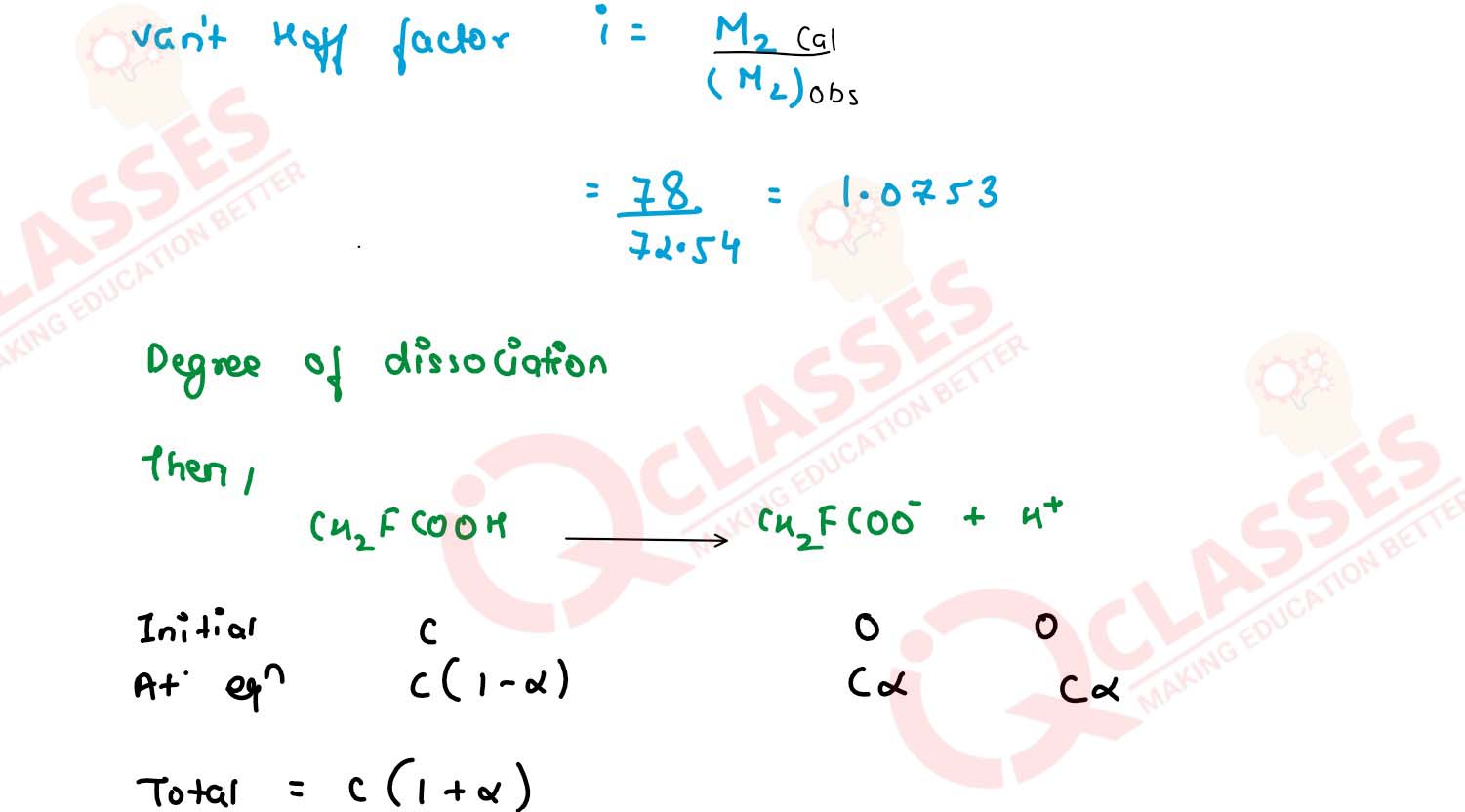
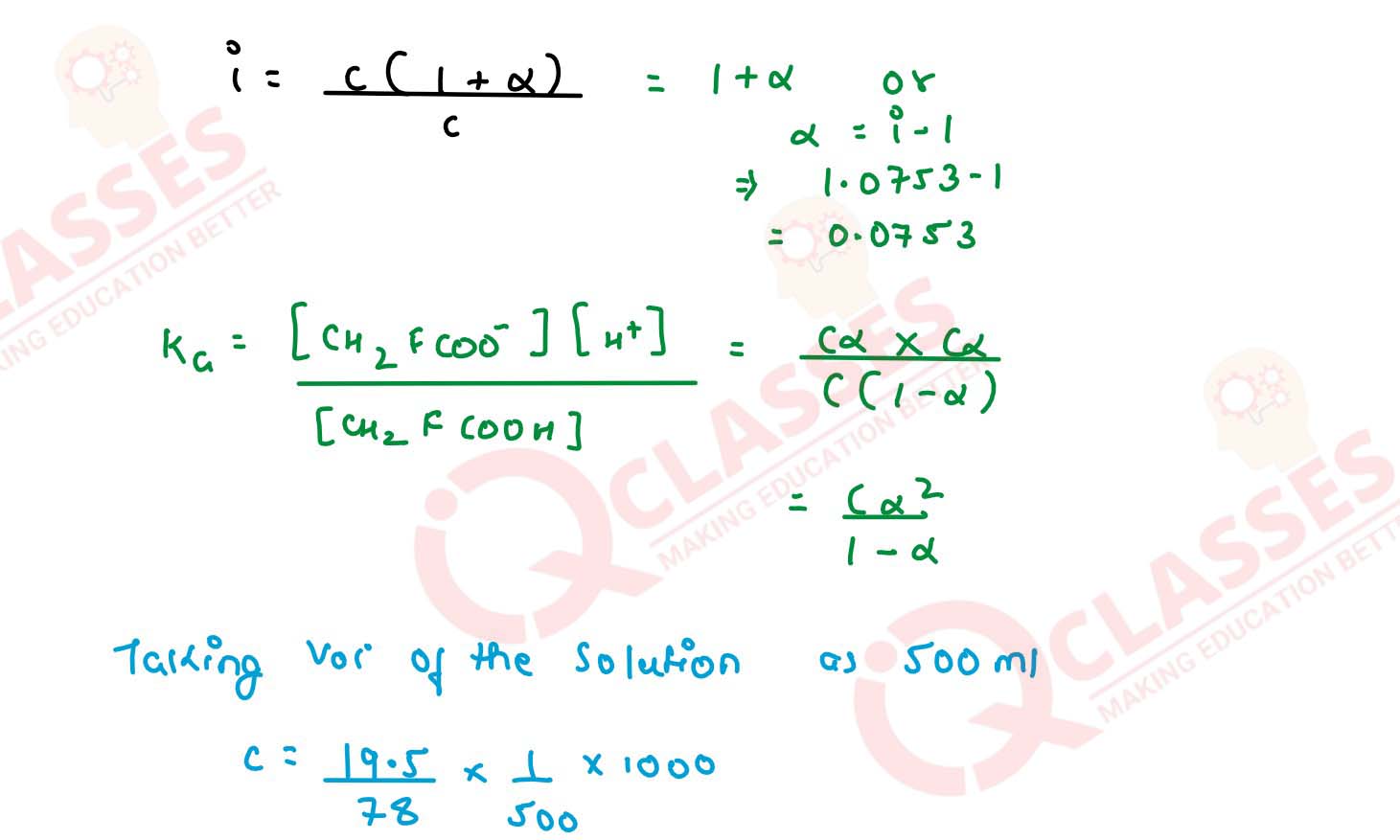





Q2.34
Vapour pressure of water at 293 K is 17.535 mm Hg. Calculate the vapour
pressure of water at 293 K when 25 g of glucose is dissolved in 450 g of water.
Solution



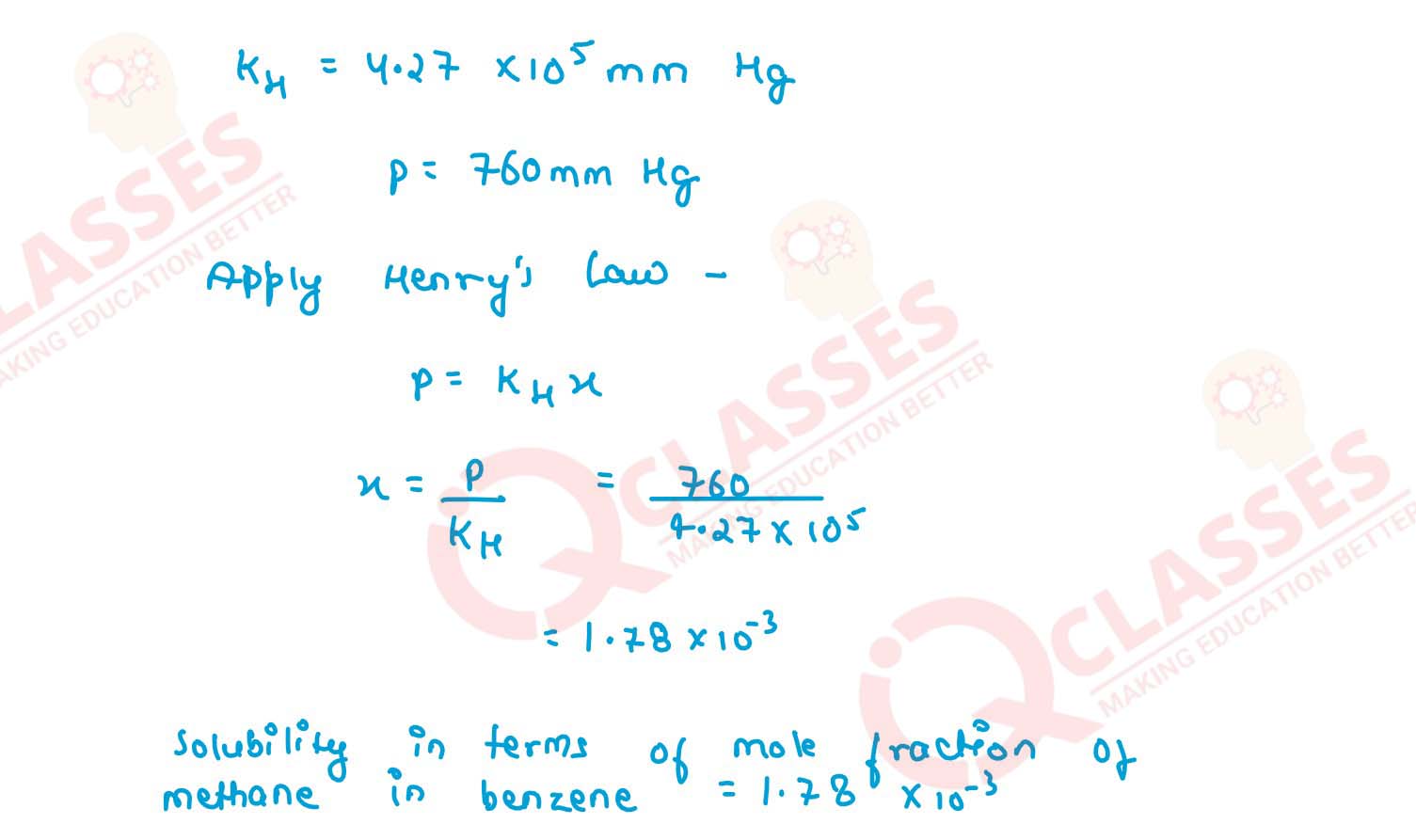




Q2.35
Henry's law constant for the molality of methane in benzene at 298 K is 4.27 x 105 mm Hg.
Calculate the solubility of methane in benzene at 298 K under 760 mm Hg.
Solution


Q2.36
100 g of liquid A (molar mass 140 g mol!) was dissolved in 1000 g of liquid B
(molar mass 180 g mol-1). The vapour pressure of pure liquid B was found to be
500 torr. Calculate the vapour pressure of pure liquid A and {ts vapour pressure
in the solution if the total vapour pressure of the solution is 475 Torr.
Solution

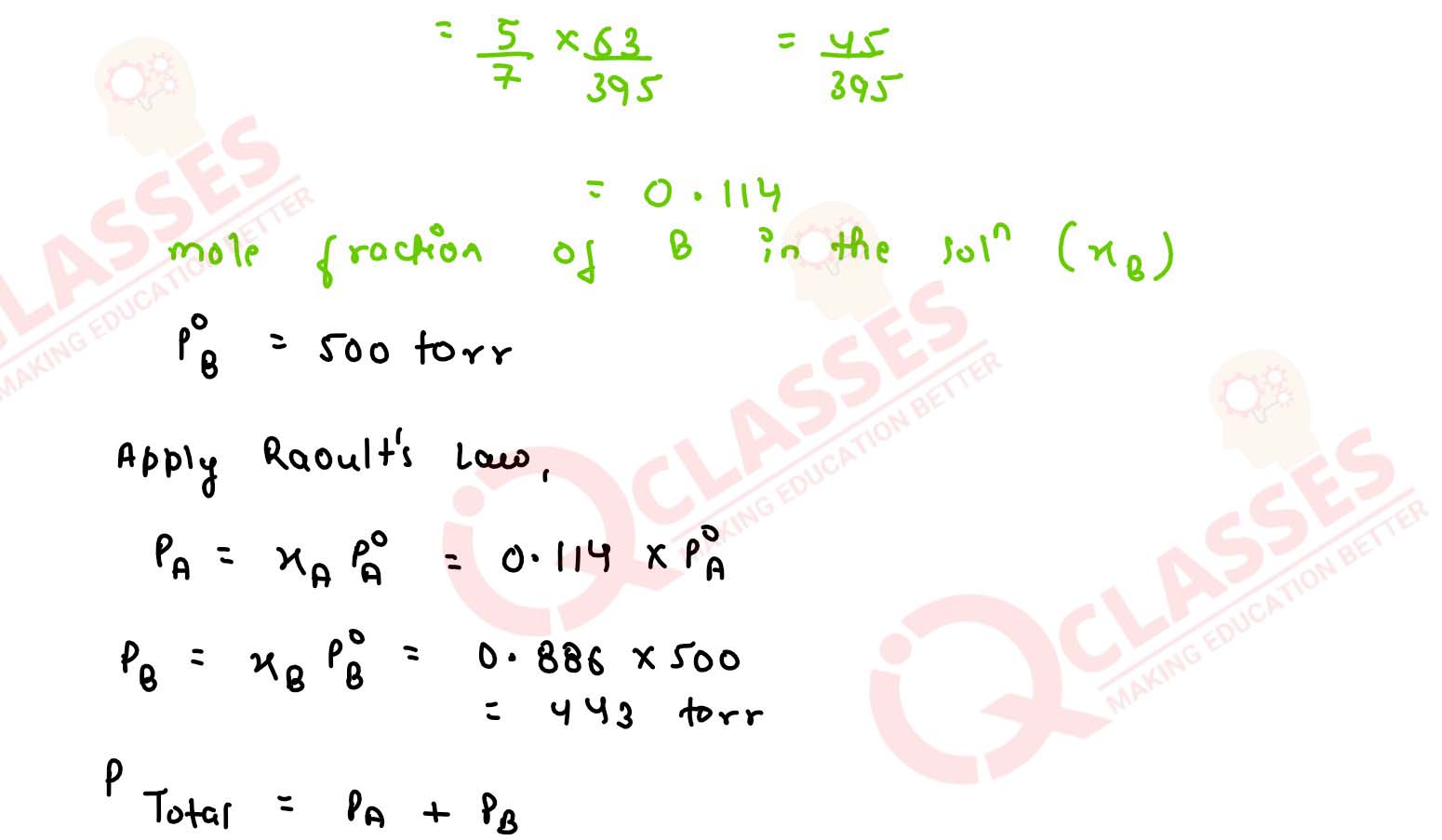




Q2.37
Vapour pressures of pure acetone and chloroform at 328 K are 741.8 mm
Hg and 632.8 mm Hg respectively. Assuming that they form Ideal solution
over the entire range of composition. Plot ptotal, pchloroform and
pacetone as a
function of xacetone The experimental data observed for different compositions
of mixture is:

Plot this data also on the same graph paper. Indicate whether it has positive deviation or negative deviation from the ideal solution. Solution

Plot this data also on the same graph paper. Indicate whether it has positive deviation or negative deviation from the ideal solution. Solution

Q2.38
Benzene and toluene form ideal solution over the entire range of composition.
The vapour pressure of pure benzene and toluene at 300 K are 50.71 mm Hg
and 32.06 mm Hg respectively. Calculate the mole fraction of benzene in vapour
phase if 80 g of benzene is mixed with 100 g of toluene.
Solution

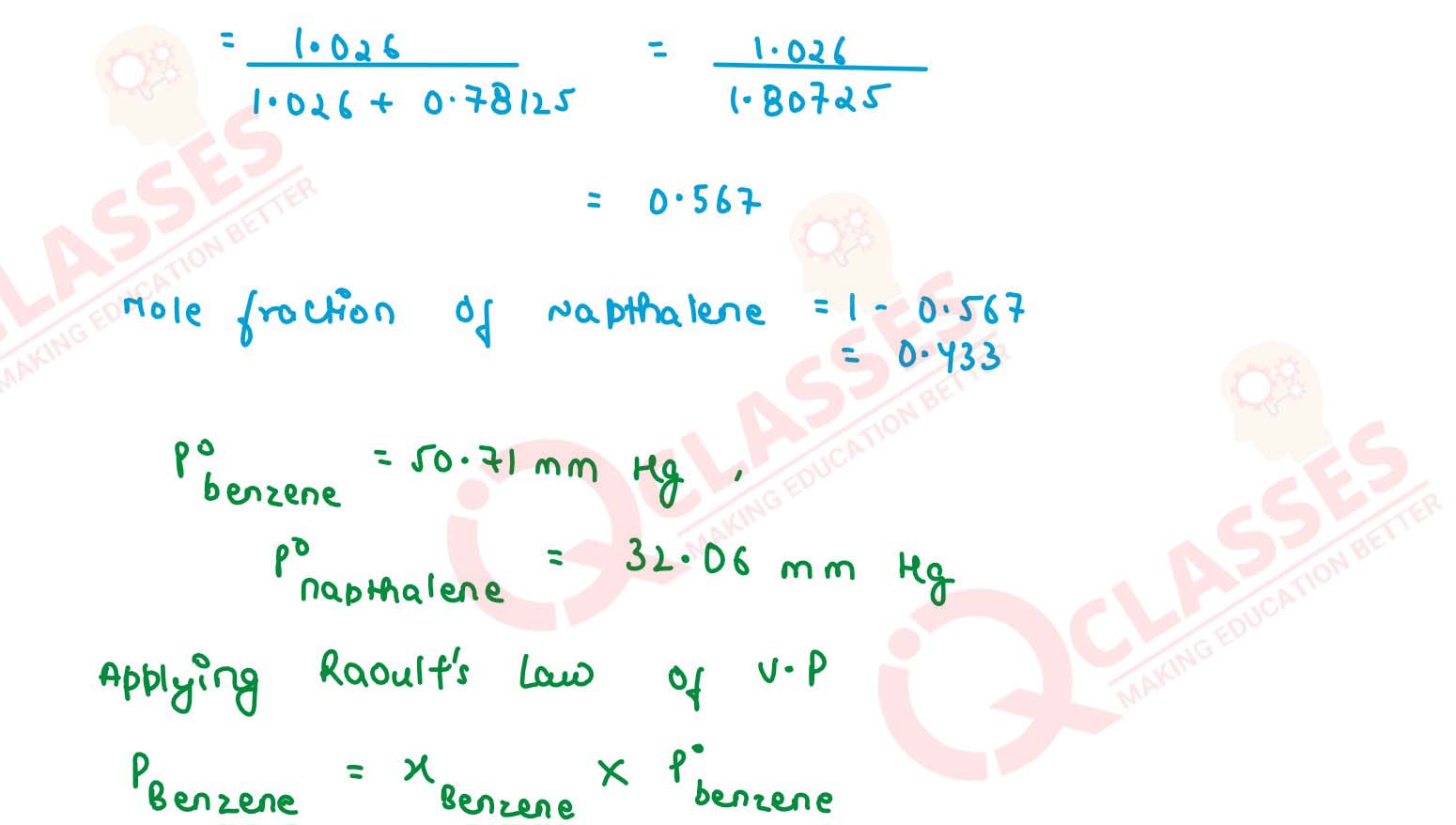




Q2.39
The air is a mixture of a number of gases. The major components are oxygen
and nitrogen with approximate proportion of 20% is to 79% by volume at 298
K. The water is in equilibrium with air at a pressure of 10 atm. At 298 K if the
Henry's law constants for oxygen and nitrogen at 298 K are 3.30 x 107 mm and
6.51 x 107 mm respectively, calculate the composition of these gases in water.
Solution

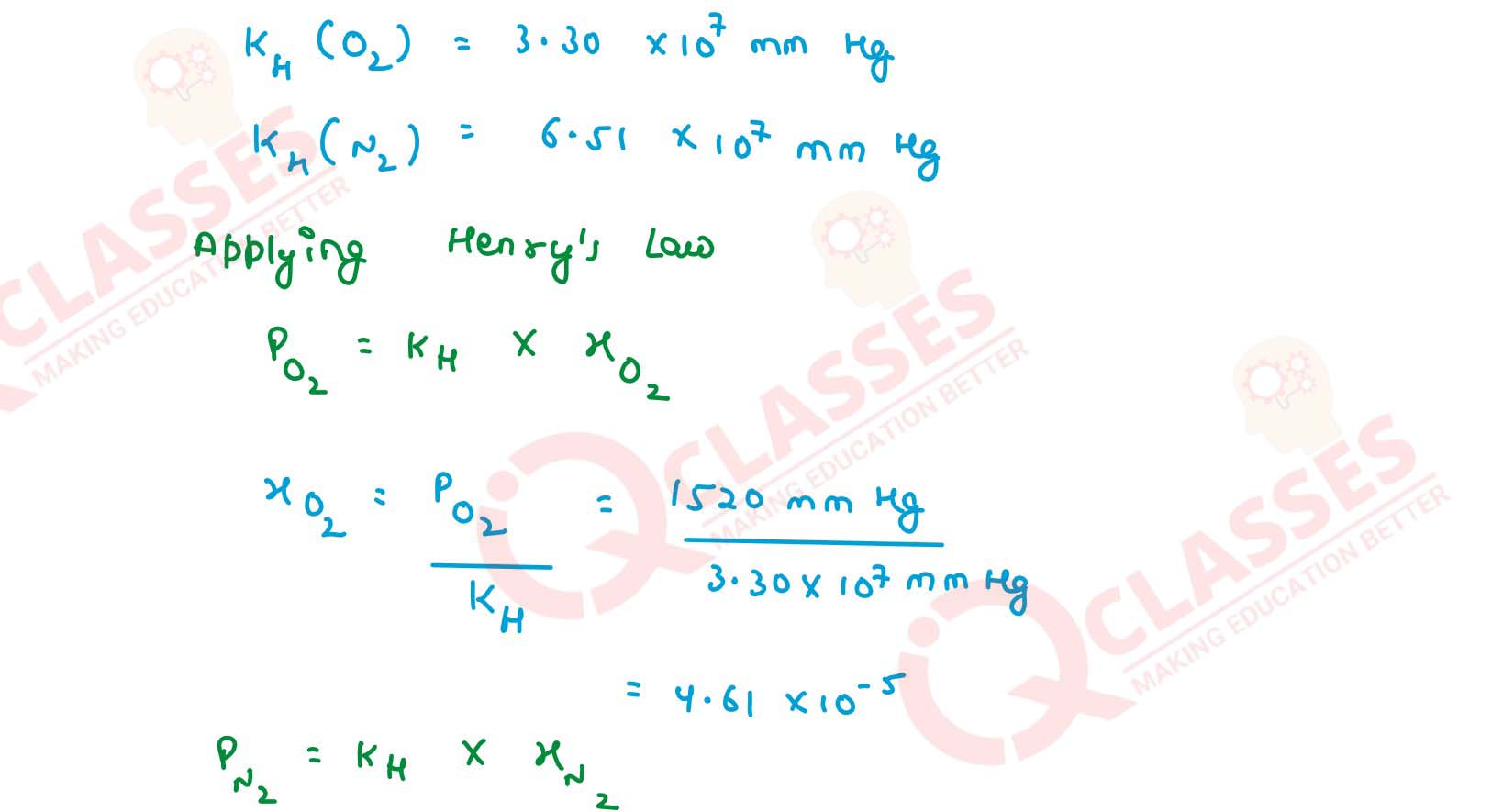




Q2.40
Determine the amount of CaCl2 (i = 2.47) dissolved in 2.5 litre of water such
that its osmotic pressure is 0.75 atm at 27° C.
Solution


Q2.41
Determine the osmotic pressure of a solution prepared by dissolving 25 mg of K2SO4
in 2 litre of water at 25° C, assuming that it is completely dissociated.
Solution



